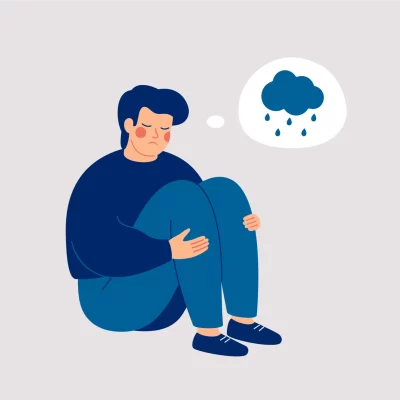It’s normal to go through periods without feeling our best or having difficulty managing mundane tasks. But when these feelings become overwhelming and start interfering with your day-to-day life, it may be time to look into what could potentially be underlying depression.
Depressive disorders are among the most common of mental disorders and health issues. About 1 in 10 adults 18 years and older suffers from a depressive disorder each year. Different depressive disorders vary in severity and symptoms – understanding each is vital to properly diagnose and treat them accordingly.
This article will discuss different types of depressive disorders, how they are diagnosed, and ways you can get help if you think you may be suffering from a depressive disorder.
1. Major Clinical Depression
Major or clinical depression is a severe, long-term form of depression that can interfere with daily life.
Major clinical depression is characterized by feelings of:
- intense sadness
- loss of interest in once enjoyable activities
- changes in appetite (sometimes leading to significant weight gain or weight loss)
- difficulty sleeping or oversleeping
- feelings of worthlessness and guilt
- difficulty concentrating
- difficulty completing simple tasks.
- feelings of hopelessness
- feeling exhausted for extended periods
For someone struggling with major clinical depression, the effects may be far-reaching. For example, a person may struggle to get out of bed each day and find it hard to focus on work or other tasks. They might feel disconnected from friends and family, isolating themselves from social situations and losing interest in things they once enjoyed.
They may also struggle to care for their basic needs, such as showering or eating regularly. These symptoms can significantly impact a person’s quality of life if left untreated.
2. Persistent Depressive Disorder
Persistent Depressive Disorder (Dysthymia) is a type of chronic depression that lasts at least two years. This disorder consists of several depressive symptoms, which have been present most days for two years.
These symptoms include:
- feelings of hopelessness and sadness
- loss of appetite or overeating
- low energy or fatigue
- difficulty concentrating and making decisions
- restlessness or irritability
- low self-esteem
While this type of depression is not as severe as a major depression or clinical depression, it can still be debilitating and interfere with daily life.
For those suffering from Persistent Depressive Disorder, it may feel like they are stuck in an endless cycle of sadness and negative thoughts. They may feel exhausted most days but unable to do anything about it, leading to further feelings of helplessness and worthlessness.
People with this disorder might struggle to complete tasks such as going to work or school due to their lack of energy or motivation.
It is also common for them to avoid social activities out of fear that they won’t be able to keep up with conversations or don’t have the energy to go out. Over time, without treatment these feelings build, resulting in a more severe form of depression.
3. Manic Depression (Bipolar Disorder)
Manic depression, also known as bipolar disorder, is a type of depressive disorder characterized by extreme shifts in mood and energy. People with this condition can experience intense episodes of mania and depression that last for days or weeks. During these episodes, their behavior may be unpredictable, and their moods may change rapidly from one extreme to the other.
In the manic phase, people can become:
- easily distracted and lack focus
- take risks without thinking about the consequences
- talk quickly and excessively
- stay awake for long hours with little need for sleep
- act impulsively without considering the results of their actions
For an individual with manic depression, the behaviors displayed during the manic phase are not typical when not in an episode.
During a depressive episode, people might appear:
- sad or hopelessly down
- lose interest in activities once enjoyed
- withdraw from friends and family
- show changes in appetite, such as eating too much or too little
- struggle to concentrate on tasks
- experience feelings of worthlessness guilt
- think about death/suicide more than usual
It is important to note that everyone experiences manic depression differently, and the symptoms may vary from person to person.
4. Postpartum Depression
Postpartum depression, also known as peripartum depression, is a type of depressive disorder that can occur after childbirth. It affects about 15% of women and can have severe consequences if left untreated for both the mother and her baby.
Postpartum depression is more than just feeling overwhelmed or stressed as a new parent; it’s an intense form of sadness that affects how you think and act daily.
For someone with postpartum depression, life may seem overwhelming in ways they never imagined before becoming a parent. They might feel like they are not bonding with their baby or lack the energy to care for them properly.
Some other common symptoms include:
- feelings of guilt or worthlessness
- fatigue
- insomnia
- irritability
- changes in appetite
- difficulty concentrating
- suicidal thoughts or impulses
It’s important to remember that although postpartum depression is common, these symptoms can still feel very isolating. There is no shame in experiencing any of these symptoms.
Remember, with the stressors on your body from childbirth and the mental and physical load of caring for a newborn child, your body and brain also need care, rest, and recovery.
5. Seasonal Affective Disorder (SAD)
Seasonal Affective Disorder, or SAD, is a type of depressive disorder that primarily affects people during winter. During this time, those affected can experience more severe symptoms of depression than they would typically feel during the summer.
Common symptoms include:
- feeling depressed most of the day
- lack of energy
- difficulty concentrating
- changes in appetite
- changes in sleep patterns
- feelings of hopelessness and worthlessness
For someone with SAD, winter can be a tough time. They might find it hard to get out of bed in the morning and struggle to focus throughout the day due to their low mood. Even activities they used to enjoy might feel like chores now—and they may withdraw from social activities as a result.
6. Psychotic Depression
Psychotic depression is a type of depressive disorder that can be incredibly debilitating. People with this condition may struggle to cope with everyday life and experience intense feelings of hopelessness.
Psychotic depression is characterized by:
- extreme sadness and despair
- hallucinations or delusions
- Other common symptoms include:
- feelings of guilt and worthlessness
- having suicidal thoughts
- changes in appetite
- fatigue
- irritability
- social withdrawal
For someone experiencing psychotic depression, daily life can feel overwhelming in ways they never imagined before being diagnosed. For example, they might have difficulty sleeping due to intrusive thoughts or difficulty concentrating on tasks for extended periods.
These episodes may last from hours up to days at a time; during these times, people with psychotic depression cannot think clearly or make decisions rationally. This can lead them down paths that could put their safety at risk if left untreated – like making impulsive decisions without considering the consequences or taking risks without thinking about what could happen next.
7. Premenstrual Dysphoric Disorder (PMDD)
Premenstrual Dysphoric Disorder (PMDD) is a type of depressive disorder affecting women before their monthly menstrual cycle. It occurs in 3-8% of reproductive-aged women and is more severe than premenstrual syndrome (PMS).
People with PMDD experience extreme symptoms of:
- depression
- irritability
- anxiety
- muscle tension
- Other common symptoms of PMDD include:
- feeling overwhelmed or out of control
- difficulty sleeping
- a sudden change in mood
- feelings of hopelessness and worthlessness
- fatigue
- changes in appetite
- difficulty concentrating
- thoughts of suicide
These symptoms can range from mild to severe, making it difficult for someone with PMDD to manage everyday tasks such as attending work or taking care of family responsibilities.
For someone with PMDD, managing the two weeks before their menstrual cycle can be incredibly difficult. They may feel like they have no control over their moods and behaviors.
Mood swings can occur sporadically throughout the day, which can be distracting and emotionally draining. These intense emotions may also lead to impulsive behavior or avoidance of social situations due to embarrassment or fear of judgment.
8. Atypical Depression
Atypical depression is a type of depressive disorder that affects people differently than other forms and types of depression do. It can be challenging to diagnose because its symptoms are not the same as classic signs of depression, such as feeling sad or having low energy.
The symptoms of atypical depression include:
- increase in appetite
- oversleeping
- mood swings
- heavy feelings in arms and legs (known as leaden paralysis)
- sensitivity to rejection
- intense feelings of guilt or worthlessness
People with atypical depression may experience episodes where they feel happy and energetic one moment and then suddenly become very down or sluggish the next. They can have trouble getting out of bed in the morning due to fatigue, even though they slept for long hours the night before.
In addition to these physical symptoms, people with atypical depression may experience difficulty concentrating on tasks for extended periods due to their low moods. Also, social activities that were once enjoyable might now feel like chores; this could cause someone with atypical depression to withdraw from their friends and family members, which only exacerbates their condition further.
9. Situational Depression
Situational depression, also known as reactive depression or adjustment disorder, is a type of depressive disorder that occurs in response to a stressful event or situation. It can be caused by anything from the death of a loved one to financial difficulties and job loss.
Situational depression symptoms may include:
- feelings of sadness and hopelessness
- lack of energy or motivation
- changes in appetite
- changes in sleeping patterns
- difficulty concentrating on tasks at hand
- feeling disconnected from family and friends
An example of what it looks like to have situational depression would be someone who has recently lost their job due to layoffs. This person may be unable to get out of bed in the morning because they may feel depressed or overwhelmed with emotions such as grief and anxiety over their future prospects.
They might also find themselves avoiding activities they once enjoyed, such as spending time with friends, because they feel too down or guilty about being unemployed when others work hard for success.
10. Disruptive Mood Dysregulation Disorder (DMDD)
Disruptive Mood Dysregulation Disorder (DMDD) is a type of depression characterized by intense and frequent outbursts of irritability or anger. It was only recently recognized as an official mental health disorder. It was previously considered a symptom of other conditions like bipolar disorder.
While the exact cause of DMDD is unknown, it has been linked to genetics, neurotransmitter imbalances, and environmental triggers such as abuse or neglect. The symptoms associated with DMDD are typically seen in children ages 6-18 but can persist into adulthood.
Common signs include:
- persistent irritability
- angry outbursts
- difficulty regulating emotions
- low self-esteem
- poor concentration
- extreme mood instability
- sleep disturbances
- physical aggression towards others or themselves
- language difficulties
- cognitive impairment
An example of what it looks like to have DMDD would be a child who experiences angry outbursts at school due to feeling overwhelmed by their emotions. They may also have difficulty calming down after these episodes, which could lead to further problems with relationships with their peers and teachers.
In addition to this behavior change, the child may struggle with concentration in class or be unable to participate in activities they once enjoyed due to feeling overwhelmed by their emotions.
How to Diagnose the Different Types of Depressive Disorders?
The first step in diagnosing any depressive disorder is for a doctor to conduct a comprehensive physical and mental health assessment. This will help them determine if the symptoms are related to a physical illness or if it may be caused by something psychological. Depending on the results, they may refer the patient to a psychiatrist for further testing.
Once they have determined that your symptoms meet the criteria for a specific type of depression, they may use one of several methods to diagnose it. For many depressive disorders, doctors will rely on the DSM-5 criteria — a set of diagnostic guidelines developed by the American Psychiatric Association. This includes questionnaires your doctor or therapist administers to classify your symptoms into a diagnosis.
In addition to using these guidelines, some doctors may give their patients additional tests, such as blood tests or an MRI scan, to rule out other potential medical causes for their depression. Both the blood test and MRI scan are not typically needed for a depression diagnosis, but they are tools in case there are physical symptoms that need attention.
Some depressive disorders require more specific considerations during the diagnosing process. Here are some examples:
Manic depression or bipolar disorder tends to be diagnosed through multiple interviews and assessments over time to accurately identify its cyclical pattern between manic and depressive episodes.
Situational depression is usually diagnosed based on its connection with particular stressors or life events.
Atypical depression typically requires consideration for possible physical illnesses that could be contributing factors before making an official diagnosis.
With disruptive mood dysregulation disorder (DMDD), clinicians must carefully evaluate children based on their behavior over several months to differentiate this type of depression from other common childhood diagnoses such as oppositional defiant disorder (ODD).
Ultimately, each type of depressive disorder has its unique diagnostic criteria, which medical professionals should carefully evaluate before proceeding with treatment plans.
How to Get Help for Depression?
Getting help for depression can be daunting, but it doesn’t have to be. Help from mental health professionals is widely available to provide the support and resources that could be necessary to help manage the symptoms of depression.
The most crucial step in getting help is recognizing when you need it. If you are feeling overwhelmed by intense emotions or noticing changes in your behavior, mood, or concentration that last for more than two weeks, it may be time to reach out for professional assistance.
There are several ways to get help depending on your needs and resources. Talk with your primary care doctor or a licensed therapist who can evaluate your situation and needs.
Conclusion
Understanding each type of depressive disorder can help you better understand the symptoms you are currently experiencing. This knowledge can increase self-compassion during a depressive or manic state. It can also help you to communicate what you are experiencing to your therapist.
Remember that recovery from depression is possible. Whether you have bipolar disorder, seasonal affective disorder, major depression, or any of the other depressive disorders listed in this post, know that these are treatable conditions and that your depression symptoms can improve.
If you don’t yet have a licensed therapist, there are professionals available who specialize in providing comprehensive treatments tailored specifically for you. If you think you may benefit from this type of therapy, call us or make an appointment here to begin your healing journey.
9 Practical Coping Skills For Depression








